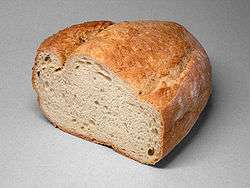Barm
Barm is the foam or scum formed on the top of a fermenting liquid, such as beer, wine,[1] or feedstock for spirits or industrial ethanol distillation. It is used to leaven bread, or set up fermentation in a new batch of liquor. Barm, as a leaven, has also been made from ground millet combined with must out of wine-tubs[2] and is sometimes used in English baking as a synonym for a natural leaven.[3] Various cultures derived from barm, usually Saccharomyces cerevisiae, became ancestral to most forms of brewer's yeast and baker's yeast currently on the market.
In Ireland, barm is used in the traditional production of barmbrack, a fruited bread. Despite the name, the barm cakes of northern England are not necessarily made with barm.
References
Notes
- Chisholm, Hugh, ed. (1911). . Encyclopædia Britannica. 3 (11th ed.). Cambridge University Press. p. 407.
- Botham's of Whitby. "The story behind a loaf of bread".
- Reinhart, Peter (1998). Crust and Crumb. Berkeley, CA: Ten Speed Press. ISBN 1-58008-802-3. Reinhart derived the term from his training under Monica Spiller.
This article is issued from Wikipedia. The text is licensed under Creative Commons - Attribution - Sharealike. Additional terms may apply for the media files.
